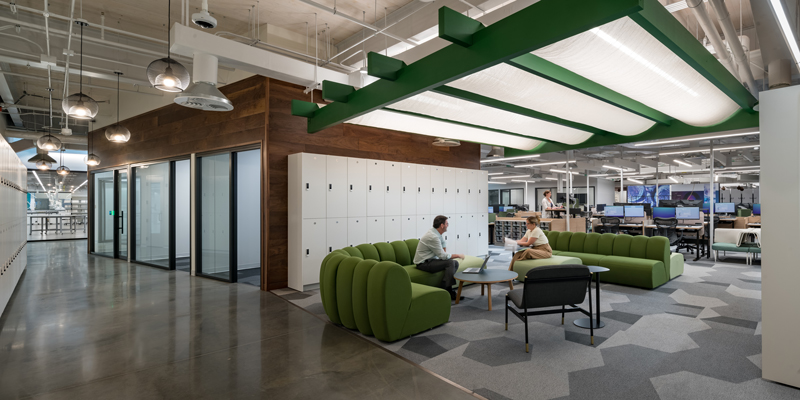By Jennie Taveras, Life Sciences Sector Leader, STO Building Group, & Pete Kobelt, Director of Mass Timber Solutions, STO Building Group
As the demand for life sciences facilities grows, so does the need for innovative, sustainable, and efficient construction solutions. Enter mass timber: a versatile and eco-friendly building material poised to revolutionize the design and construction of life sciences spaces. From the environmental benefits to the aesthetic qualities, mass timber offers a fresh take on the future of life sciences facilities.
In this article, we explore five ways mass timber will reshape the design of life sciences facilities, highlighting its potential to meet the industry’s demands for sustainability, flexibility, and advanced functionality.
1. A Spotlight on Sustainability
Life sciences organizations are increasingly aligning their missions with sustainability goals, and mass timber is a natural fit. Made from a renewable resource—wood—mass timber products like cross-laminated timber (CLT) and glue-laminated timber (Glulam) sequester carbon throughout their lifecycle, unlike high embodied energy materials like steel and concrete, which emit significant CO₂ during production.
Incorporating mass timber into life sciences facilities allows companies to:
- Reduce their carbon footprint.
- Achieve certifications like LEED or WELL.
- Demonstrate a commitment to environmental stewardship—a growing expectation from employees, investors, and clients.
For firms looking to stand out in the competitive life sciences field, a sustainable facility designed with mass timber components can be a powerful differentiator.
2. Accelerated Construction Timelines

Speed to market is critical in the life sciences space, especially as the industry continues to expand. Mass timber design and manufacturing operates in the new paradigm of DfMA—Design for Manufacturing & Assembly—which leverages:
- Prefabrication: Panels and beams are manufactured off-site to exact specifications, reducing on-site labor and construction time.
- Simplified assembly: Mass timber components are designed for quick assembly, often requiring fewer trades compared to traditional materials.
When thoughtfully planned out, these efficiencies can translate into earlier occupancy for labs and office spaces, helping tenants launch critical research, production, or manufacturing activities sooner.
3. Built-in Flexibility for Dynamic Spaces
Life sciences facilities must accommodate a range of uses, from laboratories and cleanrooms to collaborative zones and office spaces. Mass timber excels in its ability to support open floor plans and modular configurations, allowing for:
- Adaptable spaces that evolve with changing research or business needs.
- An aesthetic appeal, with exposed timber creating warm, inviting environments that enhance employee well-being and productivity.
Additionally, mass timber can be paired with other materials like steel or concrete to achieve specific structural or technical requirements, such as vibration control in sensitive laboratory areas.
4. Healthier Indoor Environments
In a high-pressure sector like life sciences, teams often spend long hours in their office or lab conducting research—and the physical spaces where this influential work takes place matters. That’s why employee well-being has emerged as a growing priority in life sciences facilities. Mass timber components can support employee well-being in the built environment by:
- Regulating humidity levels and contributing to better air quality.
- Providing natural thermal insulation, creating comfortable spaces with lower energy consumption.
- Promoting biophilic design, which integrates natural elements into built environments to reduce stress and improve cognitive function.
On top of supporting employee health and wellness, these benefits can aid recruitment and retention goals in such a competitive industry.
5. Meeting Demanding Technical Standards
While life sciences facilities require robust performance standards—such as strict fire resistance, sound insulation, and load-bearing capacity—mass timber is up to the challenge. Today, timber products can meet or exceed the stringent codes required for lab spaces, including:
- Fire safety: Mass timber chars on the surface when exposed to fire, maintaining its structural integrity for longer than traditional wood.
- Acoustic performance: Laminated timber products can be designed to minimize noise transfer, critical in research environments.
- Structural durability: Engineered timber can support the heavy equipment and infrastructure demands of life sciences operations.
These properties make mass timber a reliable and innovative solution for even the most demanding projects.
The Future of Life Sciences Facilities with Mass Timber
As life sciences organizations strive to balance sustainability, functionality, and innovation, mass timber offers a unique solution that addresses these priorities head-on. By embracing this material, designers and builders can create spaces that support groundbreaking research and reflect the industry’s commitment to a greener, healthier future.
Whether it’s accelerating construction timelines, enhancing flexibility, or improving indoor environments, mass timber is poised to transform the way we design life sciences facilities—setting a new standard for what these spaces can achieve.
About the Authors
Jennie Taveras holds a bachelor’s and master’s degree in chemical engineering from New York University. She’s spent her career working as an engineer and project manager for large pharmaceutical leaders. This depth of experience has armed her with a unique blend of insight into the owner’s perspective, understanding of the sector, and a record of building valued client relationships.
Pete Kobelt has been engrained in the exploration of mass timber in the US since its early days, contributing to the conception and establishment of the first CLT manufacturing plants in the US and the first and largest mass timber student housing project in the US. His passion stems from his time spent studying the dramatic advances in engineered wood manufacturing and construction in Switzerland, Austria, and Germany.